Cookery Feature - Maura O’Connell Foley’s Recipes & Recollections
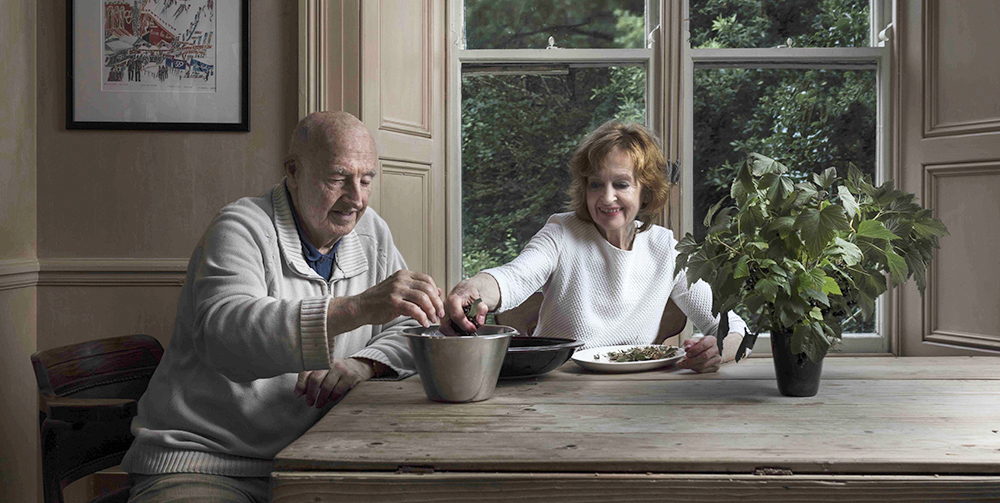
Hardly into Q2 of this extraordinary year, we have another book by an exceptional figure in Irish food. In February, Jp McMahon’s The Irish Cookbook hit the culinary headlines with its well researched and passionate celebration of this bountiful island and the cooking traditions that are so often dismissed; a wonderful gift to a new generation of cooks by one who revels in exploring the good things in our food culture.
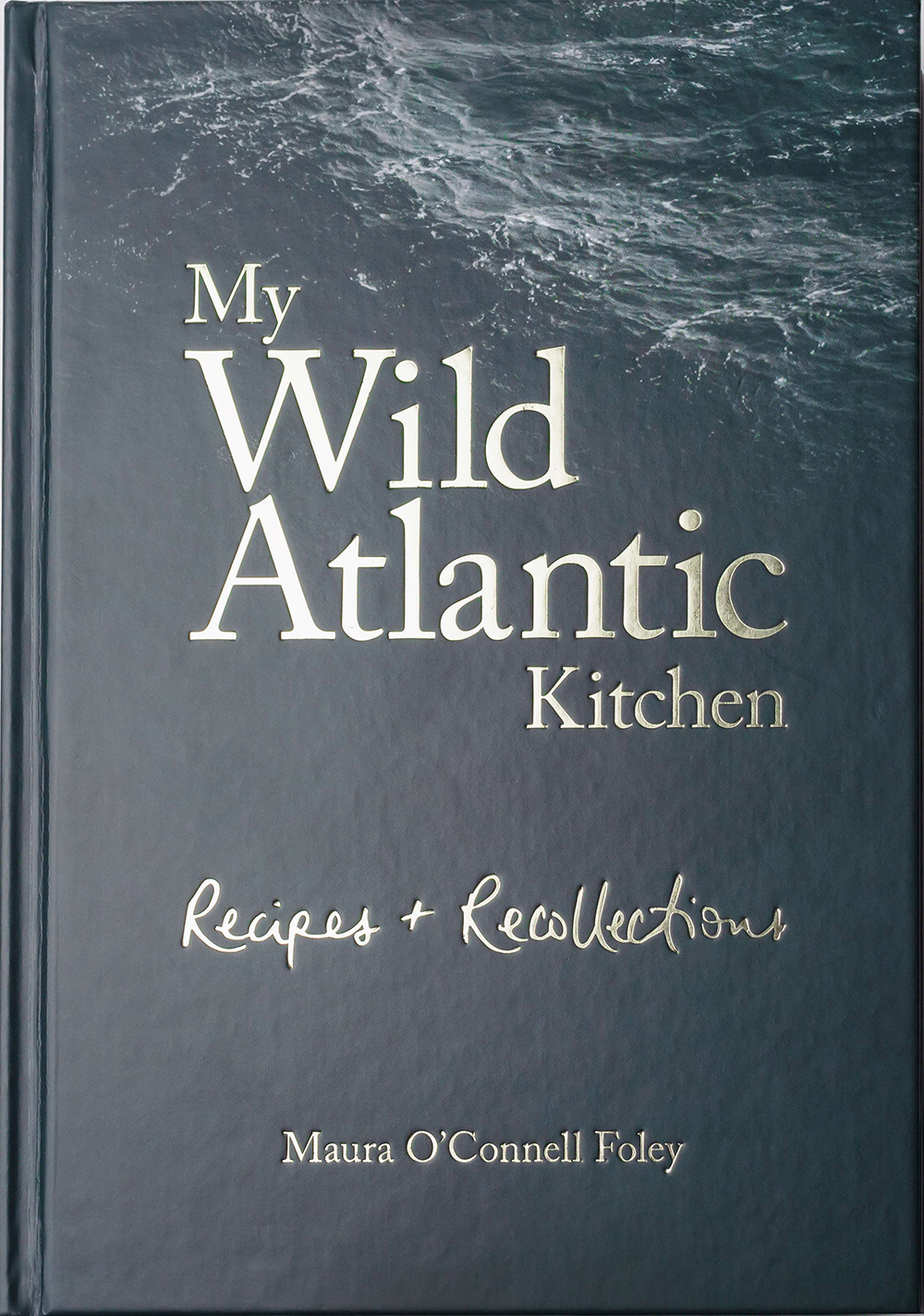 And, then came Kenmare chef Maura O’Connell Foley’s beautiful labour of love, My Wild Atlantic Kitchen, Recipes & Recollections – and what a joyful feast it is. With its meaningfully understated cover, moody Kerry landscapes and seascapes by Norman McCloskey, illustrations by artist Christine Bowen, and paintings from Pauline Bewick interspersed among over 250 favourite recipes that she has cooked over six decades, the book itself is a perfect expression of Maura’s personality and talents. (The imprint page at the back gives the team credits.)
And, then came Kenmare chef Maura O’Connell Foley’s beautiful labour of love, My Wild Atlantic Kitchen, Recipes & Recollections – and what a joyful feast it is. With its meaningfully understated cover, moody Kerry landscapes and seascapes by Norman McCloskey, illustrations by artist Christine Bowen, and paintings from Pauline Bewick interspersed among over 250 favourite recipes that she has cooked over six decades, the book itself is a perfect expression of Maura’s personality and talents. (The imprint page at the back gives the team credits.)
Maura shares the values of simplicity and careful cooking of local seasonal ingredients that made the late Myrtle Allen an iconic figurehead in the development of modern Irish food and, while not a household name in the way that Myrtle was, Maura has also been a leader throughout her long and very successful career. As well as building a loyal customer base over the years - including the playwright John B Keane, a regular “who came especially from Listowel for the scallops with Noilly Prat!” – Maura has always commanded great respect amongst her peers. Derry Clarke spoke for many when he said in his lovely Introduction: “As a fellow chef, I am proud to know her and respect her for all her achievements.”
What I really love about this book is that everything is in context – we know that Maura ‘never made the time’ to write it before, despite numerous invitations over the decades to do so, and now, with the help of family and some special friends, it has emerged not only as an expression of her life’s work and family influences but also a fascinating record of Kenmare and its development as a food destination over that time (in which she has played a key role).
The introductory section, My Life in Food, Early Life and Influences, is a wonderful read, vividly recalling the people and circumstances that made Maura the chef and – at the wonderful Shelburne Lodge, which she still runs with her husband Tom – host that she is today. We learn, for example, of her special love of fish and the fish cookery for which she is best known; opening the original Purple Heather Tea & Cake Shop with her mother Agnes in 1961 and then developing it in new premises as a restaurant and piano bar (still run by her sister, Gráinne); of early professional influences including Theodora FitzGibbon, Elizabeth David, Declan Ryan, Julia Child, Myrtle Allen and many of the great names of Irish food and hospitality in the 1970s and ‘80s; meeting Tom in 1975 and, after a whirlwind romance, marrying him just two months later; opening The Lime Tree with him in 1985 and, using her love of art and superb eye for interiors to create an atmospherically rustic space featuring Irish artwork, local pottery from Louis Mulcahy and Irish tweed; doing a stage with Sonia Stevenson at The Horn of Plenty in the early ‘80s; starting up Packies (later taken on by chef Martin Hallissey) in the early 1990s and restoring Shelburne Lodge, which they have now run with great style since 1996…
The recipes and chapter introductions continue in the same vein and, for me, that’s what makes them special. Many of the recipes are classics, or versions of well known dishes, but the way that Maura sets them in context makes them unique. The sample recipes below have been selected for their seasonality, expression of Maura’s love of local and artisan produce and possible use as an Easter menu, if circumstances permit; Kerry mountain lamb is not in season until later in the year, but lowland spring lamb can be used or even frozen mountain lamb from last autumn if available. The salmon dish is an echo of Richard Corrigan’s comment on the back cover: “The last time I stayed at Shelburne Lodge, Maura cooked me wild salmon, seared lightly and served with a lemon sauce for my breakfast. It was the finest start to the day I’ve ever had.”
My Wild Atlantic Kitchen: Recipes and Recollections by Maura O’Connell Foley (Hardback, 408pp; Design by Anchor Studio, Art director & Food Stylist Joanna Resiak. RRP €35, from www.mywildatlantickitchen.com and selected
independent bookstores, hotels and stores nationwide, or from Amazon.
RECIPES
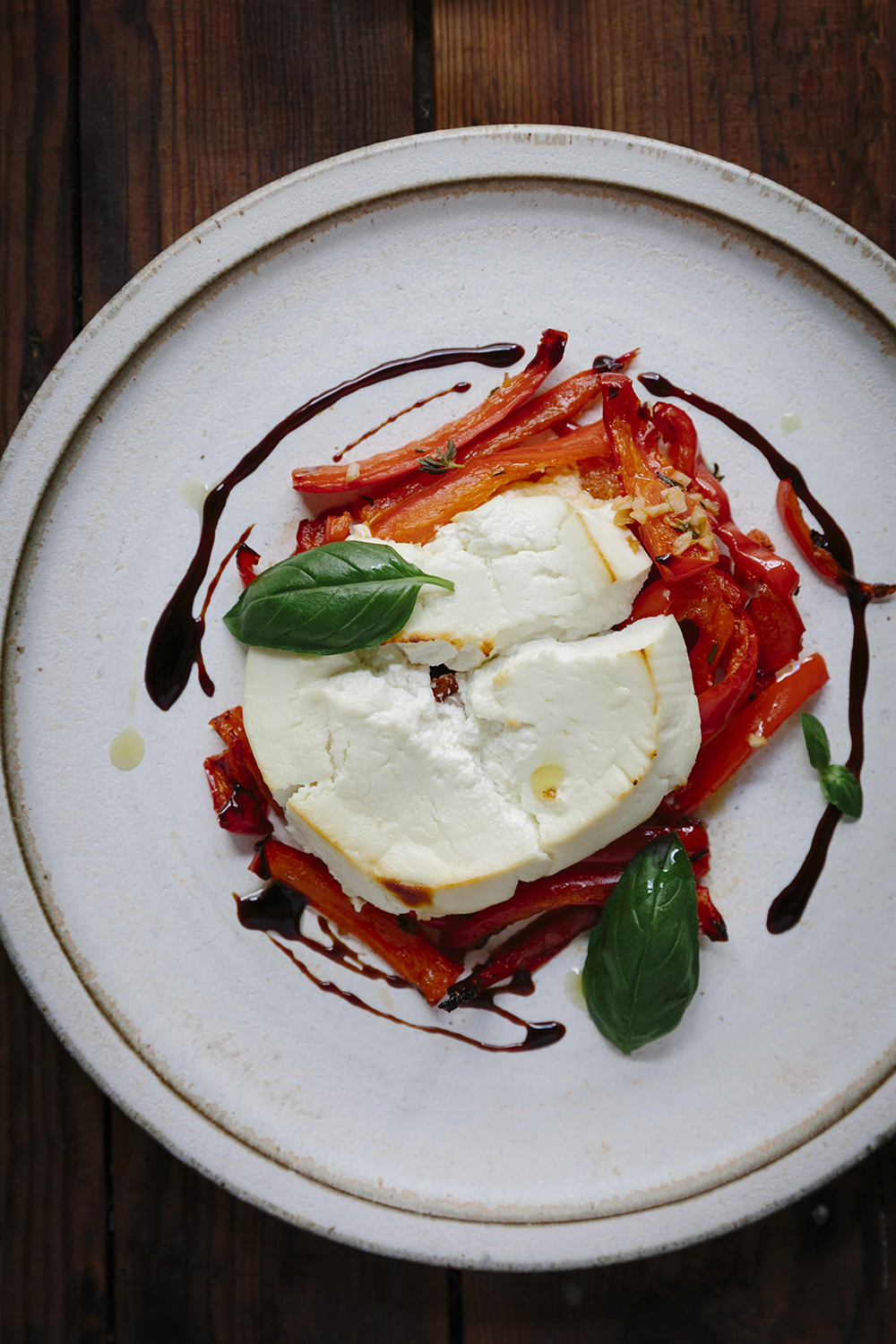 ST TOLA IRISH GOAT'S CHEESE & WARM RED PEPPER SALAD
ST TOLA IRISH GOAT'S CHEESE & WARM RED PEPPER SALAD
Meg and Derrick Gordon started St Tola Goat's Cheese in the 1980s in Inagh, Co. Clare. Gerry Galvin of Drimcong, Galway first introduced me to their cheese. He was a terrific chef and I was fortunate to do a great course in Drimcong. Every Monday when in The Lime Tree, three logs were posted to me, beautifully packaged with great care. The cheese was astounding, it came out of the oven like a soufflé! Siobhan Ni Ghairbhith, who took over business in the late 1990s, shared the same passion as the Gordons and has developed it into one of the finest farmhouse goat's cheese in Ireland. Serve with beetroot, apple and toasted almonds, hazelnuts or pine nuts as an alternative to the peppers.
Ingredients
Serves 4
Red Pepper Mixture:
• 3tbsp olive oil
• 4 red peppers, cored, seeded and sliced into batons
• 16 large fresh purple garlic doves, peeled and finely chopped
• 1 tsp fresh thyme, basil or rosemary leaves
• 1 tbsp red wine vinegar
Goat Cheese Salad:
• 4 portions of stewed red pepper mixture
• 4 slices of St Tola Irish Goat's Cheese Original Log about 2cm/ ¾ in)
• 4 handfuls of organic leaves
• Bunch of fresh basil leaves
• 4 tbsp citrus vinaigrette
Method
First make the citrus vinaigrette (see below).
Heat the oil in a large stainless steel saucepan, then add the peppers, garlic, thyme and vinegar. Reduce the heat and stew for approximately 10-12 minutes. Do not allow to brown. These can be kept in the fridge sealed in a jar for up to a week and taken out and warmed when needed. These form the base for the salad.
Preheat the oven to fan 200°C / fan 400°F / gas mark 7 or preheat the grill to medium. Prepare the peppers or, if they were prepared in advance, warm them first in a saucepan. Place the warm peppers, divided into 4 portions, in a suitable dish for the oven or grill. Place a slice of goat's cheese on top of each pepper portion. Bake in the oven for about 5-7 minutes or grill for 3-4 minutes or until the cheese is lightly golden at the edges.
To serve, use a fish slice to place each serving of peppers and goat's cheese in the centre of each plate. Spoon the reduced balsamic around the peppers and goat's cheese. Dress the leaves in a bowl; serve on the side or separately.
Citrus vinaigrette: Put 2 tbsp orange or lemon juice, 2 tsp local honey (warmed to help it combine) and 1 tsp Dijon mustard into a jar, seal tightly and shake vigorously. Add 4 tbsp extra virgin olive oil, 1 tbsp chopped herbs of choice (tarragon, chives, coriander, oregano or basil, depending on salad ingredients); season with sea salt and cracked black pepper and shake again. Taste and adjust to your liking.
Serving suggestion: 4 tbsp reduced balsamic (250ml/9 fl oz balsamic vinegar and 2 tbsp honey, reduced to about half over medium-low heat).
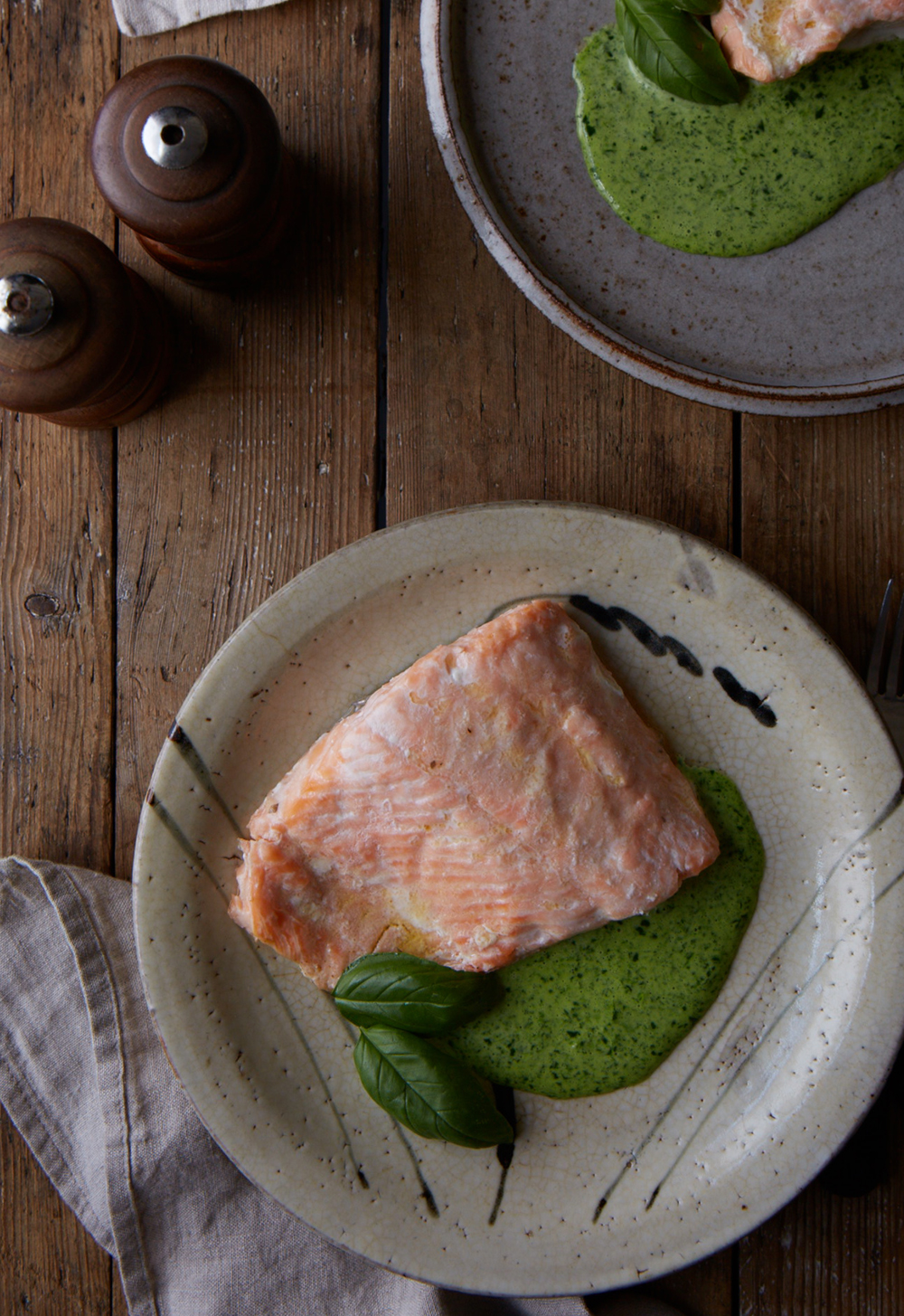 BAKED FILLET OF WILD SALMON WITH WILD SORREL HOLLANDAISE
BAKED FILLET OF WILD SALMON WITH WILD SORREL HOLLANDAISE
If you can, use spring wild salmon. They are oilier than summer wild salmon, and more robust and flavoursome by nature. Wild salmon is delicious on its own with a simple hollandaise. I served it in abundance in the 1960s. I used to stand over the stove, whisking the cold butter into my egg to get an emulsion, sometimes making a few batches a day. I spent over 20 years making it in the traditional classic fashion! Thankfully in the mid 1980s Sonia Stevenson (renowned founder of The Horn of Plenty in Devon) taught me the swift way to make hollandaise (see below) with melted butter, which is just as light and delightful.
[Note: The Wild Sorrel Hollandaise given here is ideal in spring. Maura also gives a Gooseberry, Elderflower & Lime Sauce: “With elderflowers in abundance from mid-May to June, this is the best time to showcase them in this fragrant sauce”.]
Ingredients
Serves 4
• 4 salmon fillets, wild if possible
• 55g / 2oz cold butter, cut into small pieces
• Sea salt and cracked black pepper
Wild Sorrel Hollandaise:
1 quantity of swift hollandaise sauce (see below)
Handful wild sorrel leaves, washed and dried
Serving suggestions (recipes all given in the book): Colcannon, roast fennel, fresh wilted spinach, sugar snaps
Method
Preheat the oven to fan 200°C / fan 400°F / gas mark 7. Lay out four large square pieces of foil and place each fillet on a sheet, skin side down. Season with salt and pepper then dot butter over each fillet. Fold up the sides of each foil square and loosely wrap and seal. Bake in the oven for 8-10 minutes or until cooked to your liking.
Serve with Wild Sorrel Hollandaise:
Make your hollandaise (see below). When the hollandaise is complete, add a handful of wild sorrel to the blender and blitz until it is blended - it will take only 10-20 seconds. The salmon is also delicious with hollandaise on its own. Serve with a sprig of fennel.
Swift Hollandaise Sauce
My first encounter with hollandaise was in a Swiss restaurant, Maison Suisse, owned by two sisters in London in the 1950s. My aunt brought me there as a teenager on special occasions. I remember vividly the chicken dish with a white wine cream sauce, the one both my aunt and I especially went for. They also served globe artichokes with hollandaise, and, being my first taste of the sauce, I was in awe. To this day it is still one of my favourite sauces. This basic swift hollandaise is thanks to Sonia Stevenson and to a food processor. The butter must be hot and foaming and initially added slowly to the processor.
Ingredients Makes 200-250ml/ 7-9fl oz
Egg Base:
• 225g/8oz butter
• 2 tbsp cold water
• 2 egg yolks
• Swift Method: 1 tbsp fresh lemon juice, more to taste if needed
In a small saucepan, melt the butter until it starts to boil then remove from the heat. Meanwhile, place the water and yolks in a food processor and blend until pale and fluffy. Very gradually start to pour the hot foaming butter via the funnel into the processor, keeping the motor running, until it starts to emulsify. You can then add the remaining butter more swiftly while still hot. Add lemon juice via the funnel and blend. Add more to taste if needed. Transfer the hollandaise into the saucepan used to melt the butter and cover with a lid. If not serving immediately, place the saucepan over another saucepan of hot water to keep warm until serving.
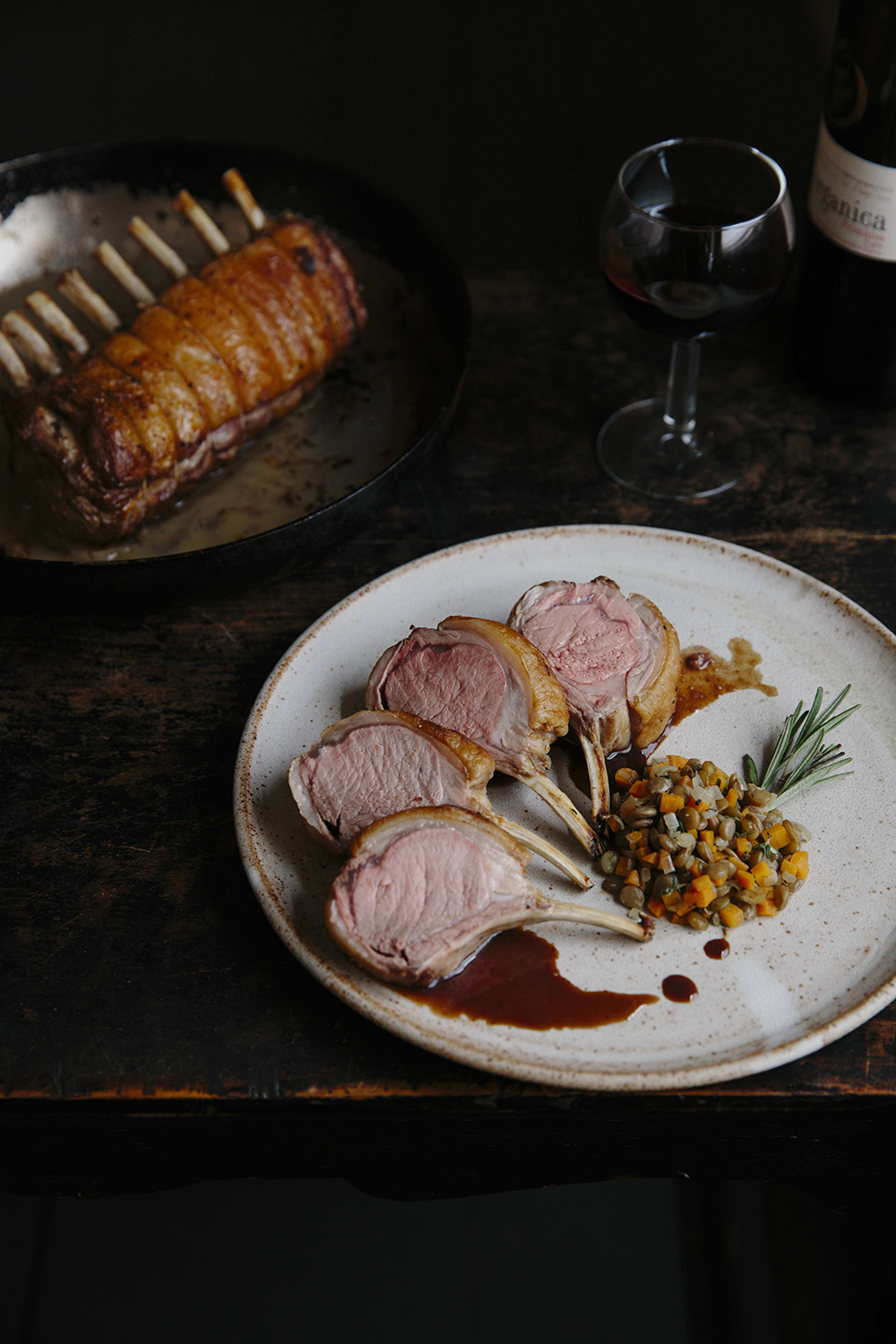 RACK OF LAMB WITH PUY LENTILS AND RED WINE SAUCE
RACK OF LAMB WITH PUY LENTILS AND RED WINE SAUCE
Our Kerry mountain lamb feeds on the beautiful wild mountain herbs giving it its distinct and special flavour. Kerry lamb is used in all good kitchens and Connemara lamb is equally fantastic.
[In the restaurant, before we roasted the lamb, we would divide the best end into two [allowing a rack of 4 cutlets per portion. We cooked the rack whole and sliced it into 4 cutlets per portion before serving. Fat should be left on the meat to protect it and give it a greater flavour. In spring and early summer, paloise is a superb sauce to accompany the lamb - this is a bearnaise using mint instead of tarragon - or it can be served with a fast and easy red wine jus, using the residue in the roasting pan. In late summer and autumn, a stronger flavoured rich red wine sauce can be used, enhanced with rosemary and garlic (the recipes are all given in the book).
Ingredients
Serves 4
• 2 best ends of lamb with fat on, French trimmed by your butcher (4 racks of 4 cutlets per person, each rack cooked whole)
• 20g / ¾ oz butter, melted
• 250g/9oz puy lentils (or dark speckled), washed under water until the liquid is clear
• 55g/2oz butter
• 3 shallots, finely diced
• 2 medium carrots, peeled and finely diced
• 1 tbsp fresh thyme leaves, chopped
• Sea salt and cracked black pepper
• Choice of sauces as mentioned above
• A few sprigs of rosemary, to garnish
Serving suggestions (all recipes given in the book): Buttered carrots, colcannon, roast beetroot, sugar snaps with mint, garden peas.
Method
Preheat the oven to fan 200°C / fan 400°F / gas mark 7.
Brush the meat with the melted butter on both sides. Heat an ovenproof pan over a medium-high heat. Add the lamb fat side down to seal for 2-3 minutes per side or until all the fat is golden brown.
Move the pan into the oven and cook for about 20 minutes for rare, 25 minutes for medium rare, or longer depending on how well cooked you would like the lamb. Cooking time will depend on the meat. Remove the lamb from the pan and rest for 10 minutes.
To make the lentils, add the lentils to a small saucepan and cover with cold water. Bring to the boil, then reduce to a simmer and cook for 15-20 minutes or until the lentils have just a small bite to them. Drain and rinse well. In another small saucepan, melt the butter over a low-medium heat. Add the shallots, cover and sweat gently for 10 minutes or until very soft. Stir in the carrots and thyme and sweat for a further 5 minutes. Stir in the lentils and season to taste.
Serve 4 cutlets per person with the puy lentils and sauce.
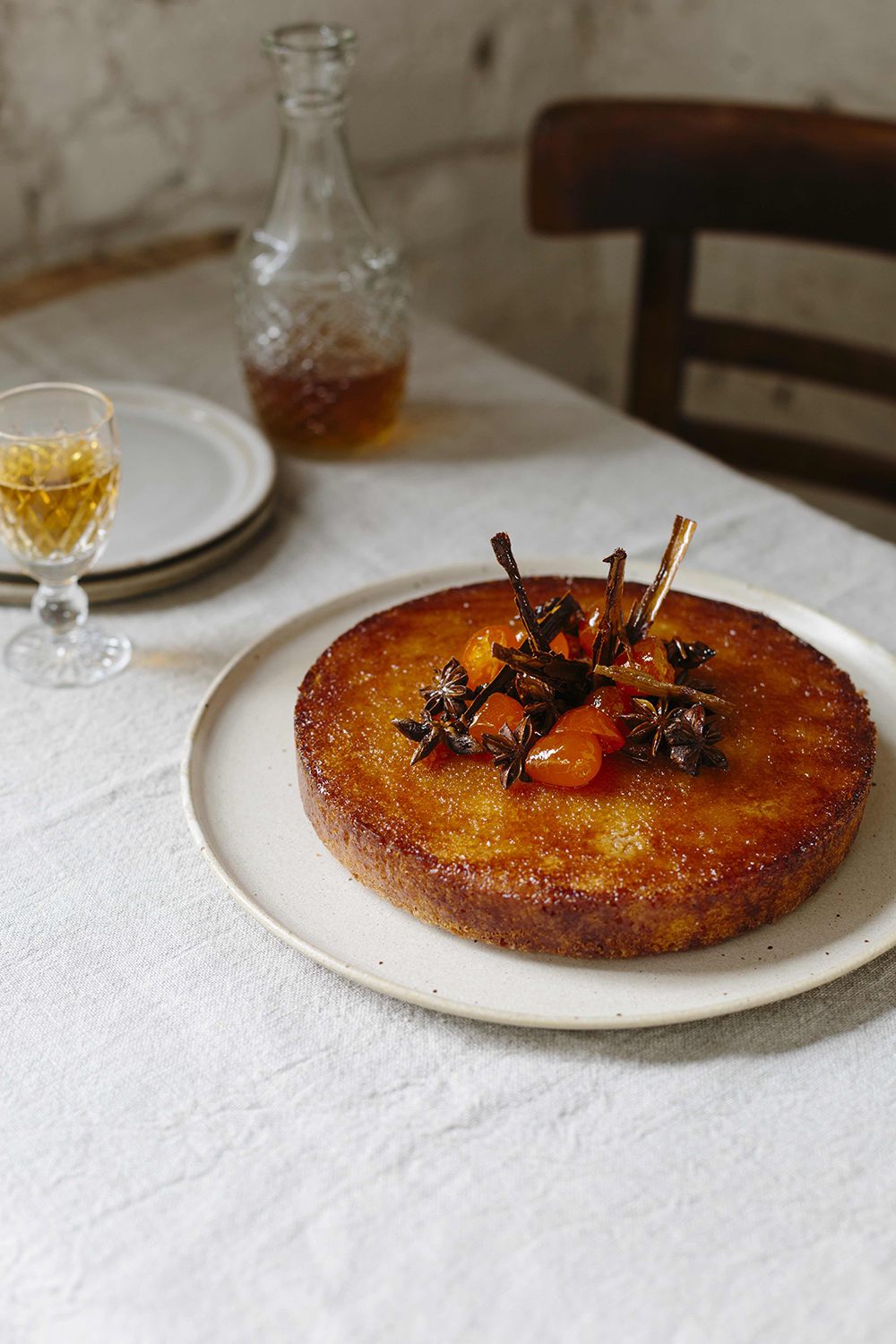 TUNISIAN ORANGE CAKE
TUNISIAN ORANGE CAKE
This is a favourite cake in my family and it was requested by my daughter and son-in-law for their wedding. I made numerous batches which were for the dessert and when I was making the main cake, my Rational oven decided to give up during the process! My good friend James Mulchrone of Jam Cafés kindly came to my rescue and produced the most exquisite large Tunisian cake. It was a work of art. This cake is worth making in double quantities just so one can be frozen for later. For a special occasion, add 2 tbsp of Grand Marnier to the syrup.
Serves 8-10
Ingredients
Cake:
• 45g / 1½ oz fresh soft white breadcrumbs
• 200g / 7oz caster sugar
• 100g / 3½ oz ground almonds
• 1 tsp baking powder
• Zest of 1 orange
• Zest of ½ lemon
• 200ml / 7fl oz sunflower oil
• 4 medium eggs, at room temperature
Syrup:
• Juice of 1 orange
• Juice of 1 lemon
• 70g / 2½ oz sugar
• ½ cinnamon stick
• 5 star anise
• 6-7 kumquats, cut in half
Serving suggestion: Clotted cream
Method
Line and grease a 20cm / 8in spring-form cake tin.
In a large bowl, mix together the breadcrumbs, sugar, ground almonds and baking powder, then add the orange and lemon zest. In a separate bowl, lightly whisk together the oil and eggs. Pour the egg and oil mixture into the dry ingredients and combine well.
Pour the cake batter into the prepared tin and place in a cold oven. Turn the oven to fan 180°C / fan 350°F / gas mark 6 and bake for 40-45 minutes or until a skewer inserted comes out clean. Allow the cake to cool in the tin for 5 minutes, then turn out upside down onto a large plate.
To make the syrup, combine all the ingredients in a small saucepan and gently bring to the boil, stirring to dissolve the sugar. Boil for 2 minutes to a light syrupy consistency. Take out the spices and kumquats and reserve for decoration.
While the cake is still warm, use a thin steel skewer to poke holes over the cake. Slowly pour over the syrup, allowing it to be absorbed before adding more.
Decorate the cake with the reserved spices (splitting the cinnamon stick is effective), kumquats and serve with clotted cream.





There are currently no comments
Leave a comment
Not a member? Register for your free membership now!
Or leave a comment by logging in with: